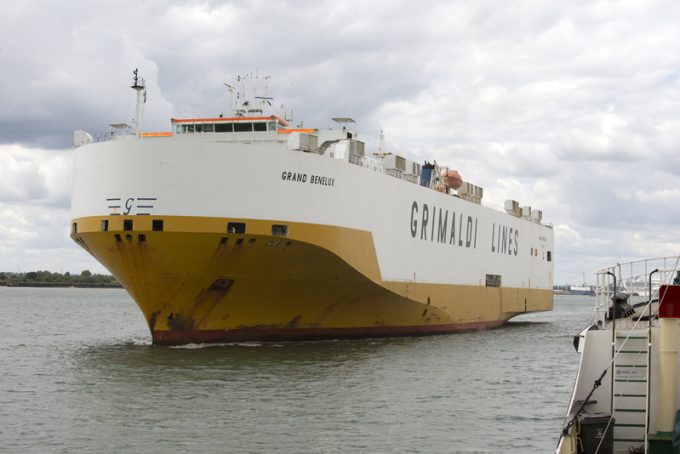Peregrine Storrs-Fox moves to consultancy role after 40 years with TT Club
One of the supply chain industry’s most celebrated advocates of safety issues, the TT Club’s ...
UPS: MULTI-MILLION PENALTY FOR UNFAIR EARNINGS DISCLOSUREWTC: PUNISHEDVW: UNDER PRESSUREKNIN: APAC LEADERSHIP WATCHZIM: TAKING PROFITPEP: MINOR HOLDINGS CONSOLIDATIONDHL: GREEN DEALBA: WIND OF CHANGEMAERSK: BULLISH CALLXPO: HEDGE FUNDS ENGINEF: CHOPPING BOARDWTC: NEW RECORDZIM: BALANCE SHEET IN CHECKZIM: SURGING
UPS: MULTI-MILLION PENALTY FOR UNFAIR EARNINGS DISCLOSUREWTC: PUNISHEDVW: UNDER PRESSUREKNIN: APAC LEADERSHIP WATCHZIM: TAKING PROFITPEP: MINOR HOLDINGS CONSOLIDATIONDHL: GREEN DEALBA: WIND OF CHANGEMAERSK: BULLISH CALLXPO: HEDGE FUNDS ENGINEF: CHOPPING BOARDWTC: NEW RECORDZIM: BALANCE SHEET IN CHECKZIM: SURGING

PRESS RELEASE
20 March 2024, London: The Vehicle Carrier Safety Forum (VCSF) publishes its first industry good practice guidelines entitled ‘Common Guidance on the loading and presentation of vehicles’. The guidance, and supporting checklist, are intended to reduce the risks associated with the shipment of unaccompanied vehicles, including electric and hybrid vehicles, and to promote the safety of terminal and vessel personnel and the protection of property including the vessel itself.
The Vehicle Carrier Safety Forum is a consortium of vessel operators, insurers and other industry experts, whose role is promote safety on vessels designed to carry vehicles. The guidance is supported by industry bodies The International Group of P&I Clubs, The International Chamber of Shipping and the TT Club.
The guidelines are intended to be used in conjunction with specific procedures from individual vehicle manufacturers, shippers, terminals or carriers in respect of information such as vehicle separation on board the vessel or emergency response.
Geir Jorgensen, Chair of the IG P&I Ships’ Technical Committee, is a strong supporter of the guidelines, “It’s great to see a new safety initiative, the Vehicle Carrier Safety Forum, coming together to produce its first guidance based on shared best practice. The fact that a push for change is coming from vessel operators themselves shows a very welcome, proactive approach to safe operations.”
Philip Bacon, Vice President Commercial Operations of Siem Shipping, who is part of the Vehicle Carrier Safety Forum Steering Committee says “The guidance is designed assist vessel operators and their partners in the transport chain to discuss the safety aspects of booking, planning, presenting vehicles at the terminal, the loading and stowage of vehicles onboard and monitoring during the voyage. The guidance has been written to be used in conjunction with procedures already in place on ships, at terminals and in the wider transport chain. It is particularly important at a time when the risk profile is changing due to the increasing numbers of electric and larger-battery hybrid vehicles being shipped. For example, the increased weight of electric vehicles needs to be considered when a stowage plan is being produced. Vessel operators are also concerned around the changing requirement for fire response where a fire involves lithium-ion batteries, and fire protection starts with identification, loading and stowage of vehicles.”
Peregrine Storrs Fox, Risk Management Director at the TT Club comments; ”Our port operator members welcomed the chance to work with the VCSF in an open and constructive fashion to produce guidelines which we consider a good foundation for individual terminals, working with shippers and carriers, to agree safe procedures.”
Lional Sharon, Marine Adviser at International Chamber of Shipping, commented; “ICS is pleased to contribute to the development of this guidance. Vehicle carriage faces new challenges from a technologically innovative market. Each party in the transport chain must understand these challenges and the role they play to ensure safe carriage. This guidance which is expected to supplement maritime regulations can play a major role in enabling safer carriage of vehicles. ICS appreciates the efforts of VCSF in promoting the safe carriage of vehicles through this guidance”.
Comment on this article